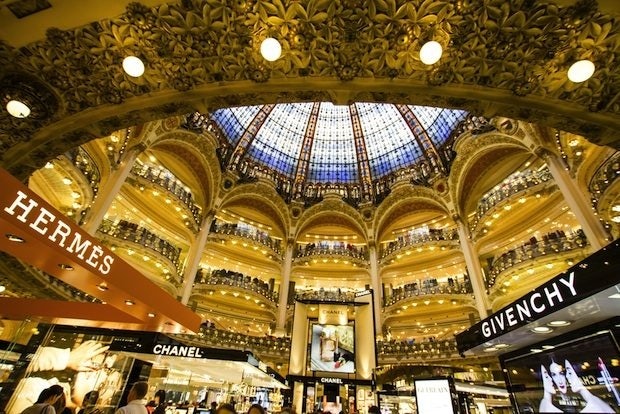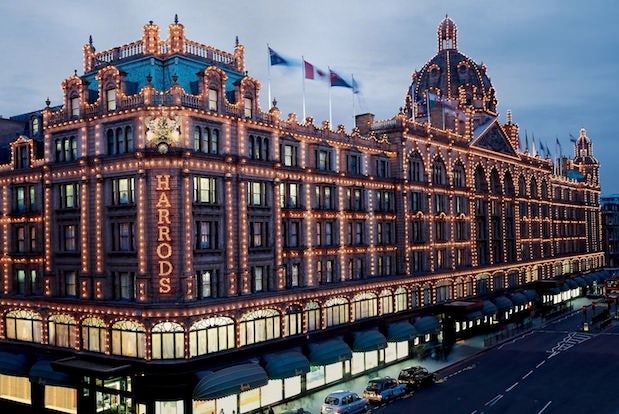
Inside Galeries Lafayette in Paris, a popular shopping spot for Chinese travelers. (Shutterstock)
This article offers a preview of our upcoming webinar with China Luxury Advisors—learn more and register here.
With mainland China’s once red-hot luxury market taking a decidedly tepid turn amid Beijing’s ongoing anti-conspicuous consumption campaign, the Chinese consumer has become an even more crucial demographic for luxury stores in the United States and Europe. Considering the explosive growth in Chinese outbound travel over the past half-decade, this is no surprise. Already the world’s top tourism spenders, having surpassed Germans with $102 billion in overseas purchases in 2012, Chinese outbound tourists (around 100 million of whom ventured overseas last year) are now a once-in-a-generation opportunity and challenge for brands worldwide. Facing a new and often unfamiliar buyer base, major luxury players need to move quickly to improve the in-store experience for Chinese shoppers without alienating their existing, loyal shoppers. To add urgency to an already pressing issue, the Chinese outbound consumer isn’t going anywhere—on the contrary, this group is expected to double in size, and their spending projected to triple, by 2020.
To get closer to understanding how to best serve the outbound Chinese consumer, it’s important to know their motivations and expectations. First off, brands need to keep in mind that Chinese shoppers—whether they’re in Barcelona, Boston, or Berlin—are seeking a bargain. High taxes in mainland China mean instant savings once Chinese borders are crossed, but the outbound Chinese shopper expects even more. They expect to receive special treatment—which generally translates to discounts, an uncomfortable prospect for luxury houses that see the “discount” as a four-letter word. This, however, has been influenced by the way luxury brands have courted Chinese consumers within mainland China since many entered the market. To get them to spend at home rather than Hong Kong or elsewhere, many luxury players have resorted to discounting on the mainland (even moreso over the past year). So don’t be shocked when Chinese tourists show up in Paris, New York, or Milan asking for discounts.

Don't be surprised if Chinese tourists ask for discounts at top luxury shopping spots.
Even for brands that won’t discount for Chinese shoppers, it’s important to give them a lasting positive experience that will drive good word-of-mouth (arguably the number one influencer of Chinese luxury purchases). Short of a double-digit discount, how can luxury brands or retailers offer this face-gaining experience? One way is by understanding the Chinese luxury buyer’s second-favorite perk: the gift with purchase. In descending order of importance, these gifts with minimum purchase can be items with high dollar value, luxury skincare samples or gift sets, perfume, and small accessories. Alternately, brands can offer attractive gifts with purchase of featured items or bundles—a popular target for tour group attendees in a hurry. Gift cards offered once shoppers hit a particular minimum spend (“Spend X, get Y in gift cards”) are another proven strategy, as well as discounts after minimum spend (“Spend X, get Y off”). Yet another incentive is a refund of state sales tax as an incentive to seal the deal in-store. Finally, VIP cards or additional in-store experiences (e.g., afternoon tea, for retailers with in-store restaurants) are employed to good effect to convert showroomers.
To ensure deals are sealed, and in-store experiences leave Chinese shoppers apt to recommend your brand to friends and family back in China, it’s the responsibility of every brand and retailer to have a well-rehearsed action plan in place. Brand managers can effectively prep for the summer rush by asking themselves a few key questions:
Does your brand offer any ability to provide spot discounts? If so, what are the limits, and who has the authority to provide them?#
It’s critical to set standards and reasoning for spot discounts, including minimum spend level, matching prices in certain locations, tax refund or other discount incentives. Make sure to train staff how to handle these situations.
Are you ready for the (Chinese) holiday season?#
Chinese holidays are a great trigger for special promotions to Chinese shoppers. Designate attractive gifts with purchase (limited edition, unique to your area, high value, desirable to Chinese customer, unique among other brands). But beware of overused gifts, such as luggage tags, and those with negative connotations (e.g., white candles).
Are you ready to greet shoppers?#
Big-ticket sales are often made or lost through easy communication. If your store has Mandarin-speaking staff, make sure to position them near the door and throughout the store to ensure Chinese shoppers don’t get lost, confused, or frustrated in the mix.
Is payment a breeze?#
With the majority of Chinese outbound shoppers using China UnionPay, brands and retailers who can take UnionPay should be ready to accept all types of CUP cards. Make sure to train staff to understand nuances of China UnionPay products: debit, pin debit, credit, pin credit, dual-brand, etc. Also, make sure to prominently display the China UnionPay placard in your window. Ensure paying for his or her expensive luxury item is the least of your Chinese shopper’s worries.
By making small, yet critical, adjustments—and ensuring a memorable, easy, and stress-free experience—luxury retailers and brands can stay one step ahead of the competition. Ultimately, what this will gain luxury players is more than simply raw sales, it’s something far more valuable: consumer loyalty, positive word-of-mouth, and long-term sales to a demographic that’s not going anywhere regardless of the luxury environment within mainland China.
Learn the secrets of sealing the deal and closing big-ticket sales with Chinese outbound luxury shoppers in China Luxury Advisors' and Jing Daily’s webinar, “The Global Chinese Consumer: Closing The Sale,” on May 20, 2014 from 11:00 AM-12:00 PM EST. If you’re not taking part, you can bet your competitors are. Don’t miss out—sign up here today.#
Avery Booker is a partner at China Luxury Advisors.
